| |
We've both been here long enough to have unusual experiences and eat unusual things. On the eating front, they've almost always been things we've chosen to eat ― nobody really springs freaky stuff on the unsuspecting gaijin. For example, one night at Hige-oyaji's place, he started showing us some more adventurous Japanese foods, including hizunamasu, a Hokkaido regional specialty. Hizunamasu is thin slices of pickled salmon head, cartilage and all. I rather liked it; it makes a nice accompaniment to a mug of beer. He also showed us his big jar of shiokara, which Wikipedia defines as "small pieces of the [sea] animal's meat in a brown viscous paste of the animal's heavily salted, fermented viscera." It's frequently served with shots of sake, perhaps to no one's surprise after that description. We'd gone there a number of times before that night, so we assumed that he'd only busted out the potentially yak-inducing fish preparations because he knew us well enough to know that we wouldn't gag or otherwise freak out. So it was with little or no trepidation that we visited a new-to-us fish restaurant earlier this week. The owner/chef had a pretty standard set of dishes on his menu: nabe teishoku (hotpot served with rice, pickles, and another side of some type); grilled fish teishoku (same thing, but with grilled fish in place of the hotpot and with miso soup); fried fish, maybe an oyster stew. Matthew ordered the seafood nabe teishoku, I went with grilled fish. Things were proceeding as they usually do until we were served. Then the following conversation took place: MAD: I don't know how to eat a whole fish head. SKD: Oh, farm. Is that shiokara? Indeed, on our trays sat little bowls of shiokara, apparently a standard teishoku dish at this restaurant. We ate our other things, glancing at the ruddy brown dish every now and again. Finally, we each bit the bullet and tried it without the benefit of sake because we still had work to do. And. . . it wasn't half bad ― it was quite salty, and tasted rather like fishy miso with bits of squid in it. Mostly, it was a good reminder of what should be the motto for our lives here: expect the unexpected.
At dinner the other night, a local friend brought a small piece of wasabi and a grater along. The grater surface is sharkskin. 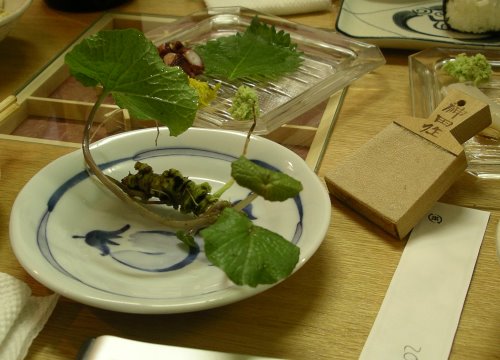 He showed us how to grate the wasabi by gently rubbing the root in circles on the grater, then let the rest of us try. We ate it on sashimi of octopus, squid, and salmon. Oishikatta desu!
Sponge cakes with strawberries, whipped cream, and placards
Cheesecakes with gold dust for holiday snackers
Chocolate yule logs with Santas and sleighs
These are a few of the cakey displays . . . Here in Japan, no Christmas is complete without a Christmas cake. Christmas cake is traditionally sponge cake with whipped cream and strawberries. It has morphed into far more extravagant things, like cheesecakes or chocolate cakes covered in ganache (melted chocolate mixed with cream, and sometimes liqueur). You can also get them decorated with white chocolate Mickey-head plaques or holiday wishes from Kitty-chan. Grocery stores, conbini, and patisseries have had these glossy brochures out for about three weeks now, advertising their scrumptious holiday wares. 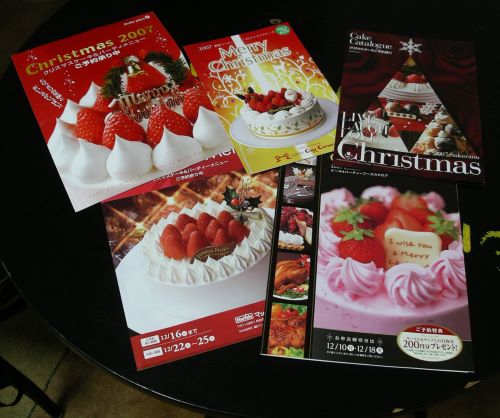
[ add comment ] permalink
Thursday, November 1, 2007, 3:17 AM FoodPosted by stefanie Fish ― the most intimidating staple of the Japanese diet. We didn't cook fish much in America, but it's so easy to get cheap, high-quality fish here that it seems ridiculous not to. Not only can it be hard to cook well, it can be hard to know how to eat. Presented with a bite-sized cross-section of river fish last year, I ate the entire thing, including the spoo (read: innards), and felt wretched immediately. About two weeks later, I learned that some Japanese don't even eat the spoo because they don't like the taste. It's apparently like nattou in that respect.
Back to fish. Cooking fish in Japan frequently means butchering it yourself. Grocery stores sell river and smaller ocean fish whole. So if you're salt-grilling, you have the option of grilling the whole thing intact and eating around the spoo and bones. Or, you can de-gill and gut it; you would also have to do this if you're making sashimi or one of the simmered dishes. I've been practicing fish butchery intermittently over the past few months, and I think I've finally got it.
The first time I butchered a mackerel, the metallic smell that accompanies bloodletting kind of freaked me out (did I have a bad mackerel?). Also, I didn't do a particularly good job of filleting it; Matthew spent the better part of dinner working his way around bones. Now, decapitating, gutting, and filleting the fish all happen cleanly with just a few careful cuts and tugs on the appropriate fish parts. (I did get a bit careless in carrying the intestines over to the sink by one end, causing a large glop of spoo to drip out and land on the floor. It is worth noting that the dogs wouldn't go anywhere near the spoo either.) Last night's miso-simmered mackerel was a predominantly bone-free delight, and the dogs scored a bit of mackerel sashimi.
We haven't tried making sashimi at home yet, but hopefully, that day will come.
[ 4 comments ] permalink
Our neighbor across the street gave us a daikon (Japanese radish) from her garden tonight. 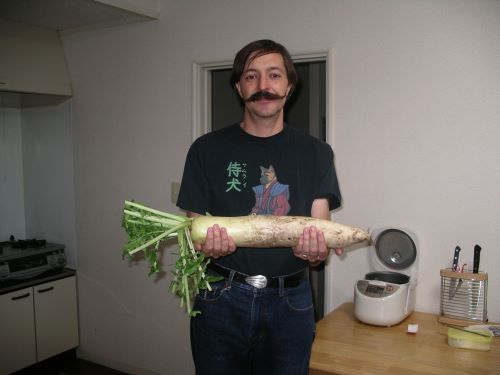 Guess I need to get pickling equipment sooner rather than later.
Gratuitous Autumn Food Photo
Sunday, October 14, 2007, 2:40 AM FoodPosted by stefanie We had a beautiful, cold autumn day today, perfect for cooking. It was also the first day I've felt up to doing anything really involved. Matthew seems to be recuperating quickly, so I decided to shake up the cooking from just soup or spicy things. We can't quite get away from the desire for spice right now, and I've added a tofu craving to the mix (Japan life = tofu cravings ― who knew?). Thus, mabo doufu was in order. Mabo doufu originates in Szechuan cuisine, according to the internets. The Japanese have adapted it by adding sake and miso to the sauce, which also includes tobanjan, a spicy Chinese bean paste. I made a Japanese interpretation, and it totally hit the spot. 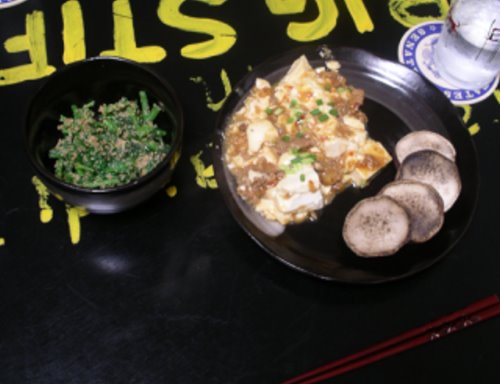 I plated it with some grilled satsumaimo ― Japanese sweet potatoes. I wanted the potatoes unadulterated because the mabo doufu and the third dish (more in a minute) both had very strong flavors, so I didn't oil them (bad call) or anything prior to grilling. Unfortunately, they were a) totally fugly; and b) good, but not complementary to the other dishes. Which was too bad, because I love satsumaimo. They're autumn produce, so there's plenty of time to make more. I rounded out our dinner with a simple dish of hourenso no goma-ae, spinach dressed with sesame. My cookbook tells me this is technically a winter dish, but I figured I was in the clear because October in Tohoku might as well be winter. It was lovely and tasty, but as with the satsumoimo, it didn't harmonize so well with the other dishes. Clearly, I've still got a lot to learn about arranging menus here.
Friday, October 12, 2007, 12:02 AM FoodPosted by stefanie After a week of cold-induced sloth, I'm finally returning to life and the world. Judging from the number of people around town sporting medical masks today, it's not just me. And Matthew seems to be getting the cold now, which is a bummer because we have a Sunday road trip planned. Also because the cold blows, even if you're able to find some measure of relief.
Early in the cold, I started thinking like a New Mexican in search of a remedy. When we had colds in the States, we'd rely on green chile to help clear out our heads. A bowl of green chile stew is like a sauna: partaking leaves you all sweaty and drained, but you're certainly breathing easier. It is superior to a sauna, however, because it comes with tortillas.
Without ready access to green chile, we had to look elsewhere for our capsaicin fix. Fortunately, we are very close to Korea, which has its own frequently incendiary delight — kimchi. Kimchi, or fermented cabbage that is often mixed with a red chile paste, is widely available in local restaurants and stores. I did not feel like cooking much (that should tell you something), so the delivery udon joint was getting a lot of love from us last weekend. A bowl or two of pirikara (spicy-hot) udon and an order of kimchi chahan (Japanese fried rice) later, and I felt less like I had a particularly efficient marshmallow factory operating in my head. Unfortunately, kimchi doesn't do anything for the insomnia and fatigue accompanying the cold, but between being able to sleep and able to breathe, I'd rather be able to breathe.
So, while I'm feeling much better, the course of treatment has had a lingering effect: mad kimchi cravings. And the opportunity to eat more kimchi may be the one silver lining if Matthew does, in fact, develop the cold.
[ 3 comments ] permalink
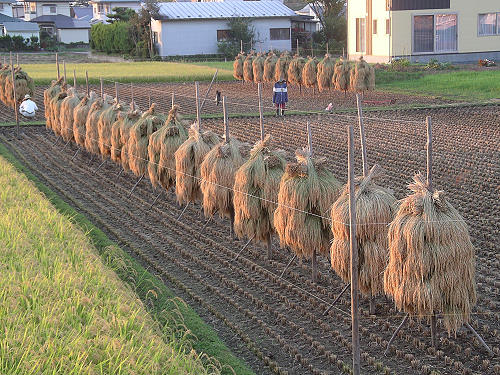 Farmers have started harvesting their rice. It gets cut and bundled, then the bundles are hung on poles. Most, like these, use vertical poles with the rice stacked in columns. Others use horizontal poles, with the rice bundles hanging over them rather like a clothesline. Incidentally, the guy in the blue jacket is not a rice farmer. In fact, he's not even a guy — he's a scarecrow! The rice farmer's the one in the white shirt.
Wednesday, September 26, 2007, 3:36 AM General, FoodPosted by stefanie Autumn is in full swing here in Kitakami. Windy days, turning leaves, and frigid nights are now routine. For now, we're using our normal covers and sleeping in long underwear, but it won't be long until we have to add the heavier cover futon and switch out the fan for the portable heaters (yikes!). Thankfully, we had a cold and clear evening for otsukimi. Traditionally celebrated by Japanese communities, otsukimi is the viewing of the first full moon in autumn. Instead of a man, Japanese see a rabbit pounding mochi (a smooth paste made of glutinous rice) in the patterns on the surface of the moon. People mark otsukimi by putting out treats made of mochi or rice flour, like dango, or autumn fruits and vegetables. I'm not aware that there was a sanctioned event in Kitakami, but we made a little celebration of it here at home by eating some usagi manjuu (bunny cakes filled with anko (adzuki bean paste)) and tsuki mochi (mochi filled with anko and made yellow, like the moon). 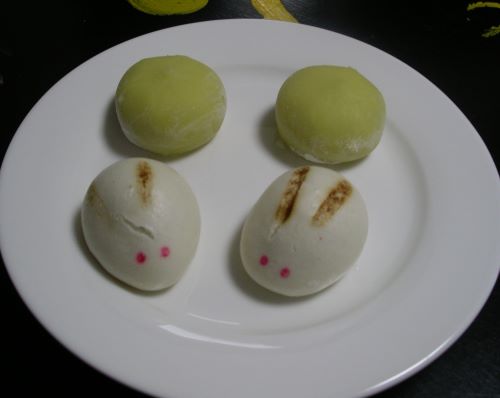 I only realized after purchase that I bought the bad-luck four pack of treats. Four is an inauspicious number in Japan; it's like thirteen to superstitious Americans. Oh, well. They tasted good. Confidential to Dunky Chuck: Happy Birthday!
Tuesday, September 18, 2007, 2:04 AM General, FoodPosted by stefanie Autumn is coming to Kitakami. I know this because the Daily Yamazaki has been touting "Autumn's Good Flavor Fair."  I couldn't tell you what the DY is contributing in terms of good flavor because the odor drove me out before I had a chance to fully contemplate the offerings. It smelled like the Wheaton Dunkin' Donuts at 3:30 in the morning on a Saturday — phoo! Autumn does seem to be prime cooking season in Japan. Kaki (persimmons) will be ripe for picking soon, mushrooms and chestnuts are peaking, and rice harvest is just around the corner. Plus, chill nights and cool mornings invite steaming bowls of rice and udon. Last week, I made my first autumn dish: miso-simmered mackerel alongside some genmai (brown rice) bought from Matthew's rice-farmer student. He and his wife had also given us some kind of a chili relish to go on the rice that tastes like nothing we've ever had before, but is totally addictive. It has that certain je ne sais Nihon that many foods here do — some essentially Japanese flavor that is rarely, if ever, found abroad.
Back Next
|
|







 Calendar
Calendar




